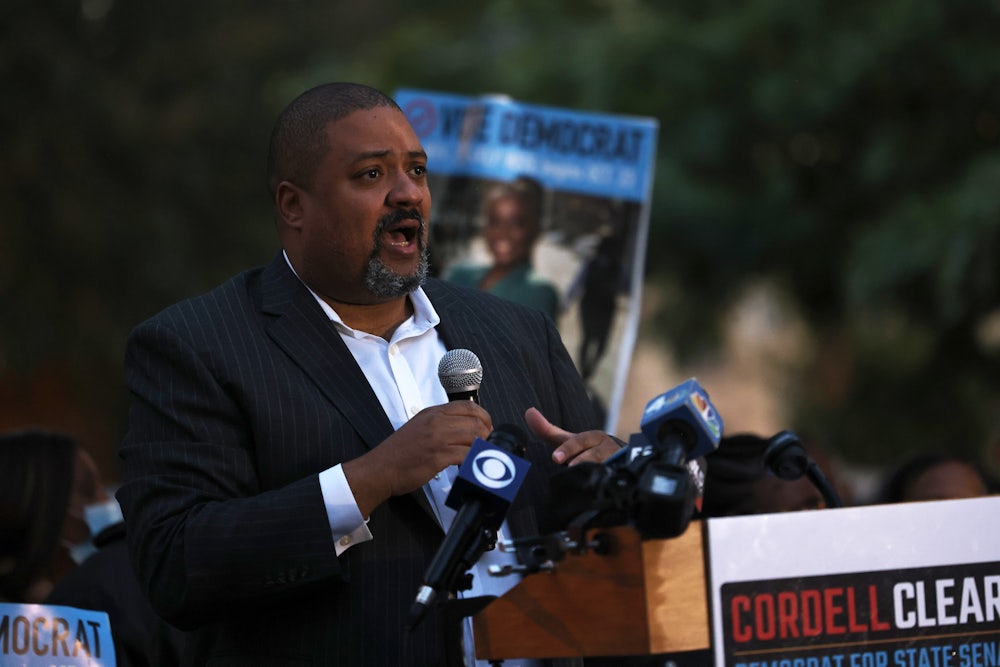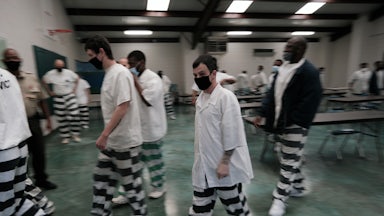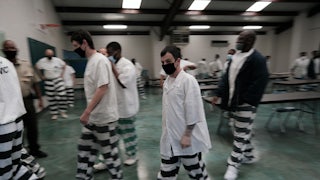Manhattan’s new District Attorney Alvin Bragg is facing intense criticism for a memo he sent to his office’s prosecutors telling them, among other things, to ask judges to send people to prison for only the most serious offenses, unless the law requires them to do otherwise. The NYPD’s new Commissioner Keechant Sewell sent an email to her officers saying, “I have studied these policies and I am very concerned about the implications to your safety as police officers, the safety of the public and justice for the victims.” Editorial boards of the city’s tabloids have criticized Bragg’s memo, and candidates for New York governor have accused him of overstepping his authority.
While Bragg and Sewell later released a joint statement saying they’d met and agreed that police and prosecutors would “work together to keep New Yorkers safe,” the criticism is still coming, particularly from staunch opponents of criminal legal reform efforts, like Andrew Giuliani (Rudy Giuliani’s son, who is running for governor), former mayoral candidate Curtis Sliwa, and the Manhattan Institute.
Much of the criticism is misplaced. First, the actual impact of Bragg’s proposals has been overstated. Bragg’s memo says that absent “extraordinary circumstances,” his office will seek incarceration only for homicides; certain violent felonies such as aggravated assault, robbery, or burglary, in which a deadly weapon causes serious physical injury; domestic violence crimes; sex crimes such as rape; and certain public corruption offenses.
In the context of the number of violent crimes in the New York Penal Code, it’s a fairly limited list. But it comes with some big caveats. To start, the list also includes any other crime where incarceration is “required by law.” Under the New York Penal Code, all violent felonies except the lowest level (Class E) carry a minimum prison term. That doesn’t necessarily render Bragg’s list moot. Prosecutors have nearly unfettered discretion in choosing what to charge—it’s why critics of mandatory minimums note that they are only mandatory for judges, not prosecutors, since the latter can simply choose to file charges that don’t face mandatory sentences—but the Penal Code’s preconditions do remove some of the memo’s bite. And while Bragg’s memo does identify cases where prosecutors should choose charges to avoid mandatory prison terms, it only points to a few, very limited, examples of such situations (in fact, perhaps only one!).
An examination of New York State prison data also shows that even under the previous Manhattan district attorney, Cyrus Vance, incarceration was a relatively rare response to victimization. In 2019, the last year with readily available data, approximately 2,500 people convicted in Manhattan were admitted to New York prisons. Of these, about 930 were convicted of violent crimes. Because the NYPD reported about 4,100 arrests for violent crimes in Manhattan in 2019, that means only about 25 percent of all violent arrests resulted in a prison admission. And in Manhattan, the NYPD made arrests in just about 30 percent of all reported rapes, 67 percent of all reported aggravated assaults, and about 67 to 75 percent of all homicides. When you take into account that many crimes go unreported in the first place, this means that memo or none, it’s already the case that prosecution is not at all the primary way we respond to violence.
Prior to Bragg’s election, most people sent to prison from Manhattan for violence fell within the categories Bragg still intends to seek prison time for. Of those roughly 930 admissions for violent offenses in 2019, only about 190 were admitted for unarmed robbery, and some fraction of those admitted for armed robbery who qualified for a limited exception would have avoided prison time under the Bragg memo. And even that likely overstates the impact of the memo, since it’s sometimes difficult to interpret conviction data when most cases are resolved with pleas. (It’s almost surely the case that some of those convicted of unarmed robbery were factually guilty of armed robbery but pleaded to a lesser offense.)
Bragg’s less-prison policy could have a significant impact for the remaining 1,600 people or so who were sent to prison from Manhattan in 2019 for nonviolent crimes. But that’s a policy move that increasingly has widespread, bipartisan support. The one category here that might cause the most alarm is firearm offenses, which are not classified as “violent.” But it’s important to note that in Manhattan, a borough with over 1.6 million people, fewer than 200 were admitted on any sort of weapons charge in 2019. And Bragg’s memo indicates that the only sort of weapons offense he’ll charge differently is possession of a non-firearm weapon.
Bragg is right on the policy. The opening two pages of the memo are an overview of the extensive literature about how prison is an inefficient-at-best, counterproductive-at-worst way to respond to crime. Studies have shown that more time spent in prison increases the risk of recidivism after release; that prison terms are overall likely to lead to more crime than less; that the primary cause of crime deterrence is the risk of getting caught, not any potential later prison time.
I want to focus on that last point, because the standard rebuttal is to say that getting caught only deters crime because of the risk of prison that comes with it. But that ignores the fact that, for many in communities of color, arrests themselves are a major form of punishment. A recent survey reported that a majority of Black respondents said they would rather be the victim of a robbery than searched by the police. Other investigations have reported that many feel the procedures used during a stop and frisk—which, like a search, is a less invasive encounter than an arrest—are essentially sexual assault.
To say that an arrest can’t deter crime without some threat of “punishment” is to grossly underestimate how negatively many view any interaction with the police. The arrest, the time spent in the station house lockup, and time spent on Rikers—nicknamed “Torture Island” and currently in the midst of a historic crisis of violence, Covid-19 infections, and a hunger strike—are serious punishments in their own right.
Moreover, it is essential to appreciate the harms that prison causes. Critics fear relying less on prison will lead to more reoffending. But a recent review of over 100 studies found that prison itself increases the risk of later reoffending. Tough-on-crime rhetoric generally doubles down at this point: Post-prison recidivism is used to justify more prison and more punitiveness. Bragg’s policies, however, reflect a far smarter way to think about this. If prison itself is a driver of recidivism, then prosecutors should seek to limit the use of prison as much as possible.
This is but one part of a bigger problem with how we discuss prisons, a problem Bragg’s memo seeks to address. We undercount the social costs of incarceration; the risk of violent victimization and rape inside prisons; the later economic pains, social stress, and health costs (even before Covid, but particularly during); loss of connection with family; not to mention the enormous emotional, social, and economic costs imposed on the family and friends of those locked up. Seeking to use prison less isn’t just a smart way to approach crime, it also reflects a greater willingness to meaningfully engage with the human costs that prison imposes.
Finally, Bragg’s memo delivers on what Manhattan voters elected him to do. Progressive prosecutors are sometimes accused of trampling on the separation of powers by declining to prosecute whole categories of crimes. Critics of Rachael Rollins, the former Suffolk County (Boston) district attorney who was just confirmed to lead the U.S. Attorney’s Office in Massachusetts, argued that the legislature has the power to determine what crimes are, and while prosecutors can decline to go after specific instances of law-breaking, they cannot undo what the legislature has done by refusing to go after entire types of offenses.
This argument ignores that while we separate our government legally—into executive, legislative, and judicial branches—we also separate it geographically, into state, county, and local agencies, especially when it comes to the criminal legal system. For a policy problem like crime, these geographic divisions matter a lot. Crime, like many social ills, is densely concentrated—not just across cities, or even neighborhoods, but within certain blocks of certain neighborhoods. For a fairly small fraction of the population, the risk of violent victimization intrudes with depressing regularity; for a large majority, however, crime is more of an abstract fear, and that majority’s responses to it are often driven by more abstract motives than actual effective, harm-minimizing safety concerns.
In many ways, this makes the state legislature the worst agency to entrust with criminal legal system policy. Those most affected by the costs of crime—and thus the costs of ineffective or cruel enforcement—have the least say in state legislatures. The more local the law enforcement agency, the more those most impacted have a voice in what it does. It’s telling that almost all of the most progressive prosecutors in the United States have been elected in urban counties where either the suburbs are all parts of other counties (Philadelphia, Baltimore, St. Louis, San Francisco, Brooklyn) or where the noncity suburbs make up an increasingly small share of the population (Portland, Boston). Similarly, Cook County State’s Attorney Kim Foxx has always done substantially better with voters in the Chicago part of Chicago than the non-Chicago part. Criminal legal system reform is often framed by critics as supported by those who are least harmed by it, but the opposite is true: Candidates with platforms that push back against punitiveness do the best where those most affected by crime and punishment have the loudest say.
This appears to hold true even within cities, although the data here is much more scant. In his primary campaign against an opponent running on a tougher-on-crime platform, Philadelphia’s Larry Krasner did best in the districts with the most shootings. A similar dynamic occurred when Krasner was reelected. One advocate said that the people who live in communities most affected by gun violence blame social conditions—not Krasner—while those who blame the district attorney “didn’t live in that community.” So those who see law enforcement up close voted for a local politician who pledged to push back against nonlocal, state-driven severity.
The people of Manhattan voted for Bragg, whose memo implements his campaign promises. Tellingly, Manhattan is also the only borough where Mayor Eric Adams—who campaigned on tougher, more conventional responses to crime—lost in the first round of New York’s ranked-choice voting election in 2021. The politics of punishment almost always tilt toward severity. Which means that when someone who campaigned against severity wins, we should take extra care to listen to what the voters wanted.
This story was produced in partnership with the Garrison Project, an independent, nonpartisan organization addressing the crisis of mass incarceration and policing.










